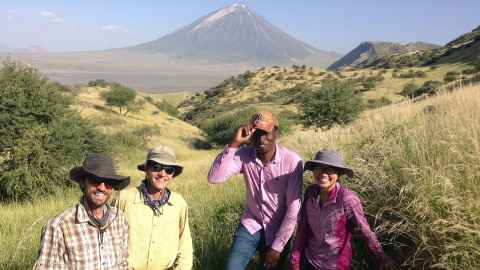Ancient CO2 mystery solved at East Africa
4 June 2020
Around 90 percent of the earth’s carbon is locked deep beneath the surface but a team of scientists has provided new understanding of how this ancient CO2 can find its way from hundreds of kilometres beneath the surface to be released into the atmosphere.

Carbon, in the form of carbon dioxide, has helped regulate the earth’s atmosphere and climate for billions of years but it is also a greenhouse gas generated by human activity that traps heat and contributes to global warming.
While the deep CO2 is hundreds of times less than that produced humans, just how it gets released and how much of it there is, is poorly understood but forms a critical part of accurately calculating the Earth’s overall carbon budget.
A key site for natural carbon emission is the East African Rift, a 3000 km-long valley that is subsiding as the tectonic plates in Africa break up the Earth’s crust during earthquakes to create pathways for deep carbon to make its way to the surface.
Previous research has shown the CO2 emitted from the Rift is higher than initially thought but highly variable along its length so that scientists still don’t know exactly where all this carbon comes from and how it is so efficiently released.
University of Auckland researcher Dr James Muirhead and a team of international researchers and students measured and analysed CO2 emissions along a 400 km length of the Rift to better understand which crustal regions release the greatest amounts of deep carbon and where it is stored.
They examined two types of ancient crustal regions – orogenic crust, where millions to billions of years ago tectonic plates were once smashed together; and cratonic crust, which sits in the interior of continents protected from tectonic plate collisions at continental boundaries and so is expected to have accumulated and stored large amounts of CO2 over billions of years.
Measurements of CO2 gas were collected in chambers placed at the surface and what the researchers found was not what they were expecting. Faults in the orogenic crust released high amounts of CO2 right near the boundary between the two types of crust.
“This zone of ancient carbon, trapped below the cratonic crust, moves deep within the earth towards orogenic crust and is then released as CO2 in the rift valley, rather than staying trapped within the Earth”, he says.
Dr Tobias Fischer from the University of New Mexico, co-lead of the study, says the findings reveal a previously unrecognised way in which ancient stores of carbon are transported within the deep Earth to be released at the surface as CO2 during continental rifting.
“It also helps explain why the East African Rift, and other ancient continental rifts, may be capable of large volume CO2 release into the atmosphere. Break up of deep stable cratonic crust may also have played a role in controlling natural atmospheric CO2 levels in the Earth’s past.”
Further research will involve measuring the total amount of CO2 emitted in regions in north Kenya that are farther away from the boundary between cratonic and orogenic crust.
“That way, we can find out how far this zone of deep CO2 release extends across East Africa”, says Dr Muirhead.
This project was funded by a US National Science Foundation grant awarded to the University of New Mexico and Syracuse University. The research team also included Sarah Oliva, Amani Laizer, Cindy Ebinger, Jolante van Wijk Claire Currie, Emily Judd, Emmanuel Kazimoto, Yuji Sano, Naoto Takahata, Christel Tiberi, Stephen Foley, Josef Dufek and Miriam Reiss.
The research is published in Nature
Media contact
Anne Beston | Media contact
DDI 09 923 3258
Mob 021 970 089
Email a.beston@auckland.ac.nz